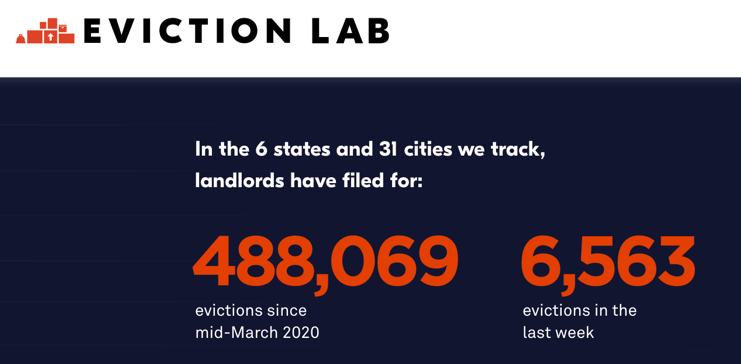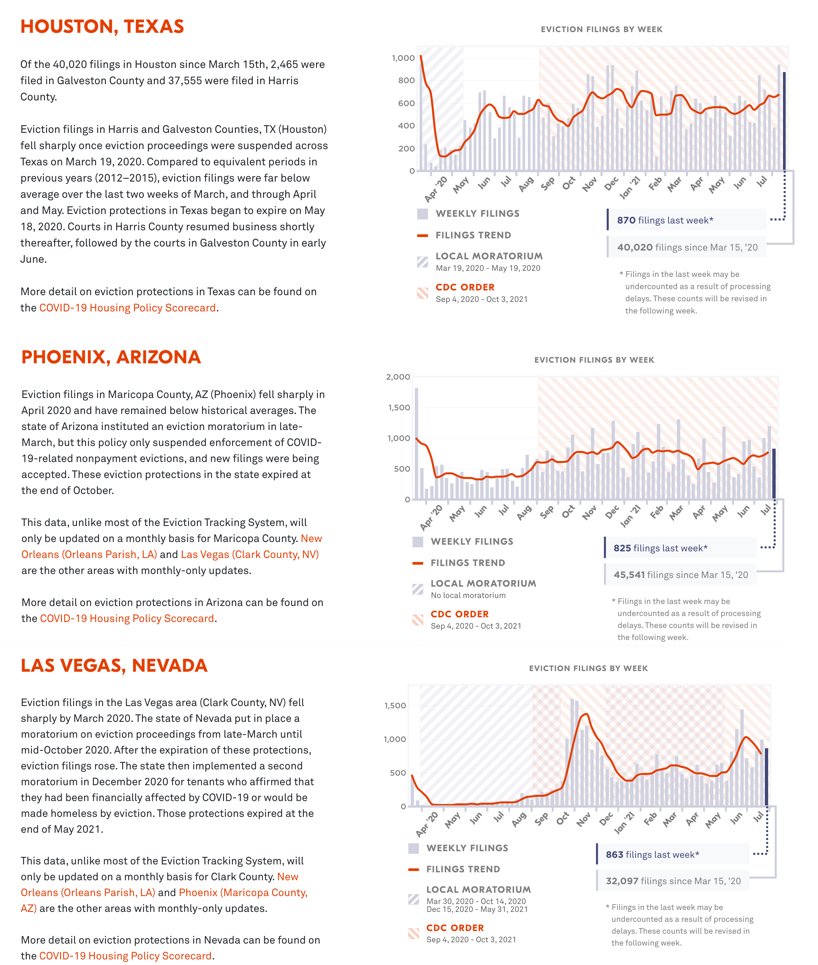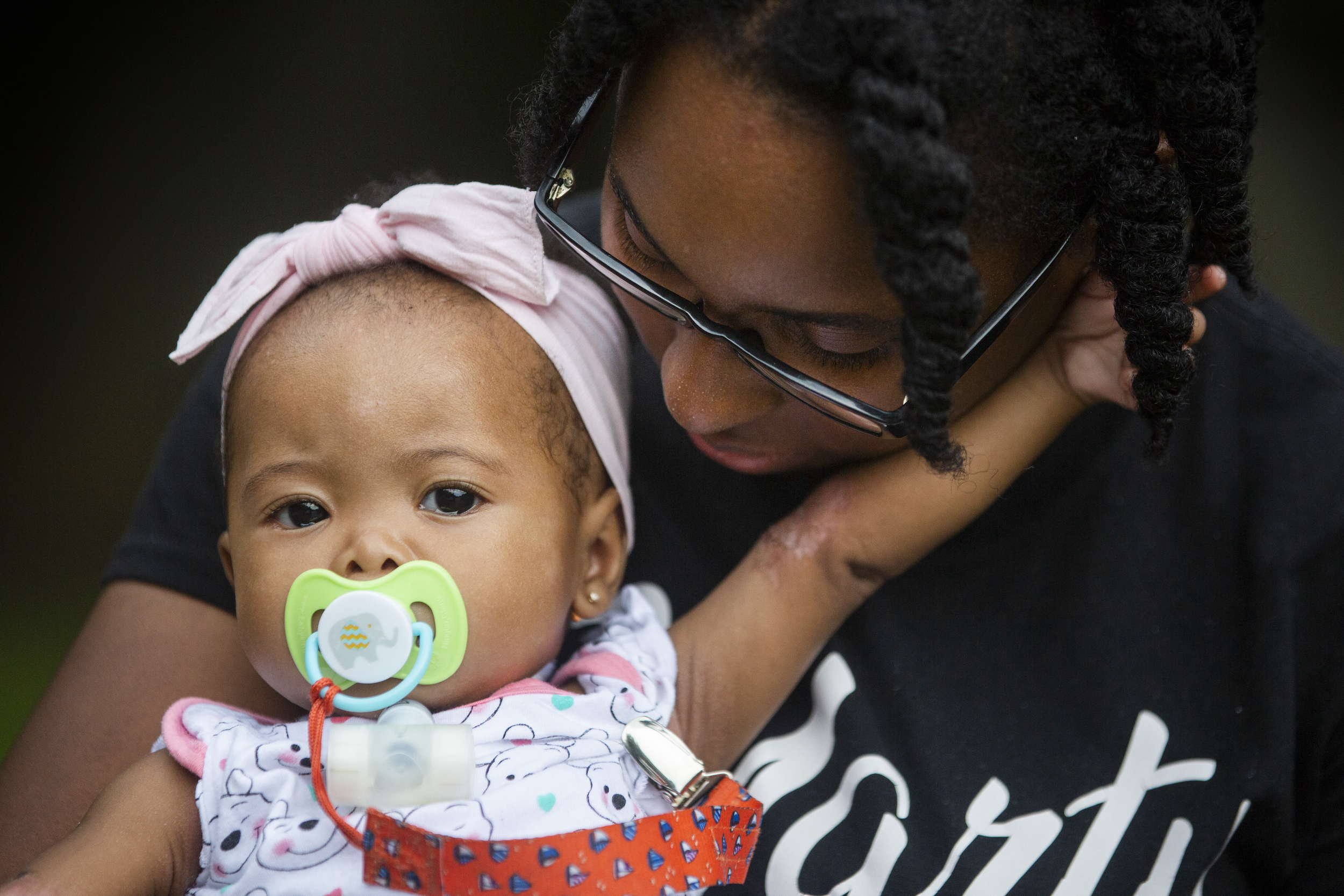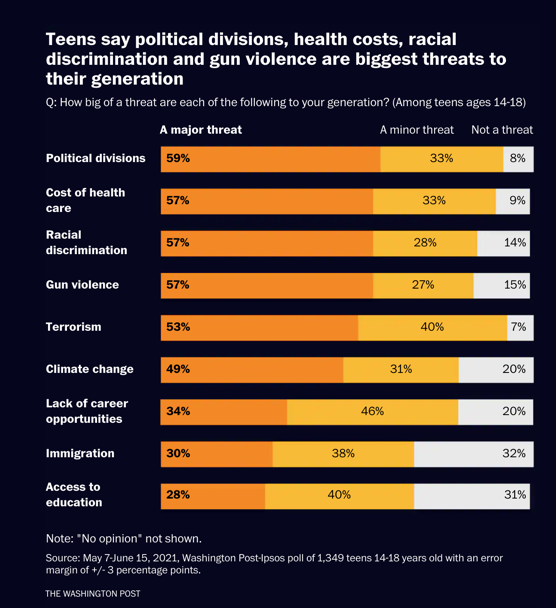 Covering COVID-19 is a daily Poynter briefing of story ideas about the coronavirus and other timely topics for journalists, written by senior faculty Al Tompkins. Sign up here to have it delivered to your inbox every weekday morning.
Covering COVID-19 is a daily Poynter briefing of story ideas about the coronavirus and other timely topics for journalists, written by senior faculty Al Tompkins. Sign up here to have it delivered to your inbox every weekday morning.
Late Thursday evening, the United States Supreme Court overturned President Joe Biden’s eviction moratorium and said the Centers for Disease Control and Prevention had overstepped its authority by issuing it. The summary judgment means that landlords can begin evictions right away in states or cities that have no moratorium of their own.
The current federal moratorium on evictions was to expire Oct 3. Landlords who filed the suit said many were forced to sell their properties after more than a year of collecting no rent.
Here are a few key passages from the eight-page ruling, which also a swipe at Congress for not acting and instead relying on the CDC:
It would be one thing if Congress had specifically authorized the action that the CDC has taken. But that has not happened. Instead, the CDC has imposed a nationwide moratorium on evictions in reliance on a decades-old statute that authorizes it to implement measures like fumigation and pest extermination. It strains credulity to believe that this statute grants the CDC the sweeping authority that it asserts.
If a federally imposed eviction moratorium is to continue, Congress must specifically authorize it.
Dissenting Justice Stephen G. Breyer (who was joined by Justices Sonia Sotomayor and Elena Kagan) wrote that the court was acting too quickly during a crisis:
The public interest strongly favors respecting the CDC’s judgment at this moment, when over 90% of counties are experiencing high transmission rates.
These questions call for considered decision-making, informed by full briefing and argument. Their answers impact the health of millions. We should not set aside the C.D.C.’s eviction moratorium in this summary proceeding.
The CDC claimed its authority to impose a moratorium by citing §361(a) of the 1944 Public Health Service Act which, until now, was used to quarantine infected animals. It had never been used for an eviction moratorium. The act says:
The Surgeon General, with the approval of the [Secretary of Health and Human Services], is authorized to make and enforce such regulations as in his judgment are necessary to prevent the introduction, transmission, or spread of communicable diseases from foreign countries into the States or possessions, or from one State or possession into any other State or possession.
For purposes of carrying out and enforcing such regulations, the Surgeon General may provide for such inspection, fumigation, disinfection, sanitation, pest extermination, destruction of animals or articles found to be so infected or contaminated as to be sources of dangerous infection to human beings, and other measures, as in his judgment may be necessary.
The Supreme Court ruled the same way that some lower courts have looked at the CDC’s authority.
Both the Trump and Biden administrations contended that the first sentence of the at gives the CDC broad authority to take whatever measures it deems necessary to control the spread of COVID–19, including issuing the moratorium. But the Supreme Court’s ruling said the act gives no such broad authority:
But the second sentence informs the grant of authority by illustrating the kinds of measures that could be necessary: inspection, fumigation, disinfection, sanitation, pest extermination, and destruction of contaminated animals and articles. These measures directly relate to preventing the interstate spread of disease by identifying, isolating, and destroying the disease itself. The CDC’s moratorium, on the other hand, relates to interstate infection far more indirectly: If evictions occur, some subset of tenants might move from one State to another, and some subset of that group might do so while infected with COVID–19.
The ruling said the moratorium was too harmful to landlords and, if Congress intended to give the CDC such broad power, then Congress should say so in specific legislation. If you believe the CDC has the power to impose a moratorium because it is necessary, the court said, then the CDC could order all sorts of things. It gives examples:
Could the CDC, for example, mandate free grocery delivery to the homes of the sick or vulnerable? Require manufacturers to provide free computers to enable people to work from home? Order telecommunications companies to provide free high-speed Internet service to facilitate remote work?
89% of rental assistance funds are still stuck in government red tape. Time is running out again.
The last extension of the moratorium was largely an attempt to buy time while state governments try to figure out how to distribute the billions of federal dollars they are sitting on.
Last year, the federal government allocated $46.5 billion to help people who could not pay their rent. To date, $5.1 billion has been distributed to the people who need it. The distribution picked up a little bit last month, but not much.
The original eviction ban was enacted a year ago next week, Sept. 4, 2020.
The U.S. Census Bureau gives us a glimpse of the size of the problem.
More than a million households say they face eviction once the federal moratorium on evictions expires.
- 6.5 million households are “behind” on their rent payments.
- 2.8 million households have applied for rental assistance.
- A half-million have gotten help. 1.5 million are waiting.
CBS News told the story of one landlord who is now homeless because her renters could not or did not pay. The landlord had to keep paying expenses.
Yahoo Finance reports that 72% of renters who are behind on payments owe smaller “mom and pop” landlords:
That demographic is arguably one of the biggest losers in the current crisis, with the moratorium neither providing them financial relief or facilitating payment of the billions owed in back rent. Most evictions for unpaid rent have been halted since the early days of the pandemic, but 58% of smaller landlords with fewer than four units say they have tenants that are still behind on rent, according to the National Association of Realtors.
A recent Urban Institute survey showed that 28% of landlords have deferred maintenance on their properties, and 62% said it was because of financial reasons.

(Eviction Lab)
The Eviction Lab found, “Neighborhoods with the highest eviction filing rates during the pandemic have the lowest COVID-19 vaccination rates.”
The Eviction Lab tracks evictions in 31 cities. Here is a sample of some of the highest number of eviction cases filed recently.

(Eviction Lab)
Teens are still fairly optimistic about the future
Let’s end this week with some optimism. A new Washington Post-Ipsos poll finds that teenagers — who are growing up in a pandemic among racial discord and political tensions — still find reasons to believe the future is better than the present.
- 54% said the country’s best years are ahead of us.
- 23% said the “U.S. stands above other countries in the world.” 25% of their parents agreed. One in four teens said “there are other countries that are better than the U.S.” 15% of their parents agreed.
- 48% said it is a “good time” for teenagers to be growing up. 37% of their parents agreed.
- 51% said it is a “bad time” for teens to be growing up. 62% of parents agreed.
- 40% said it is “very likely” that they will achieve “a good standard of living as an adult.” Another 51% said it is “fairly likely.” 8% said it is “not too likely.”
- 46% said they believe that, compared to their parents’ generation, their opportunities to succeed in life are better. 16% said they believe their chances of success are worse than their parents’. A third said the chances are about the same.
In short, it seems that teens are more optimistic than their parents.
Here is a list of top concerns for today’s teens:
Here we go again — Oregon orders outdoor mask mandate

Residents wearing masks sit in downtown Lake Oswego, Ore., on Sunday, April 11, 2021. (AP Photo/Gillian Flaccus)
OK, now back to the dreary news of the pandemic that we still need to cover. Oregon Gov. Kate Brown ordered that, starting today, no matter their vaccination status, people in Oregon must wear masks in most public outdoor settings.
That includes, for example, football games and public gatherings where people are crowded together. The rule does not apply to “fleeting” outdoor encounters like sidewalks, where you would only be exposed for a short time. Children under age 5 are exempt from this order.
Oregon is the first state to take the mask mandate outdoors after relaxing it.
[the_ad id=”667826″]
Delayed surgeries, staffing shortages contribute to rising hospitalizations
Roll Call alerts us that yes, hospitals are full in some places, but not all from COVID-19. A lot of it is, however, related to COVID-19. Some of the contributing problems range from “delayed surgeries that are now urgent to mental health problems among children.” The story adds this context:
The confluence of rising COVID-19 cases with delayed non-COVID-19 medical procedures is having a ripple effect, forcing some patients who need care to travel further and further away from their homes, said Dave Dillon, the spokesman for the Missouri Hospital Association.
Even states less affected by the current wave of COVID-19 cases have reported spikes in hospitalizations and limited intensive-care bed availability as more modest increases in COVID-19 cases combine with a backlog of surgeries put off in 2020 and surges in mental health cases linked to the pandemic.
“It’s not just that more people are coming in the door, but increasingly we’re having some struggles, getting people out of the hospital, in part because we’re seeing staffing shortages, all throughout health care,” said Nancy Foster, vice president for quality and patient safety policy at the American Hospital Association.
Newest study shows fully vaccinated 29x less likely to be hospitalized, 5x less likely to be infected
I suspect you already have a sense of what this new large California study found, but it’ll ground your suspicions in data. The study is based on 43,000 patients and found that unvaccinated people were 29 times more likely to be hospitalized than vaccinated people and about five times more likely to be infected than vaccinated people.
To me, the data speaks most loudly to why full vaccination is so important. But the other important realization here is that full vaccination is not a guarantee that you will not be infected. This is the exact language in the study (and you have to read it carefully):
Much lower percentages of fully vaccinated persons infected with SARS-CoV-2 were hospitalized (3.2%), were admitted to an intensive care unit (0.5%), and required mechanical ventilation (0.2%) compared with partially vaccinated persons (6.2%, 1.0%, and 0.3%, respectively) and unvaccinated persons (7.6%, 1.5%, and 0.5%, respectively).
On July 25, the SARS-CoV-2 infection rate among unvaccinated persons was 4.9 times and the hospitalization rate was 29.2 times the rates among fully vaccinated persons.
Why babies and toddlers spread COVID more than teens

Tyesha Young holds her baby Jalayah Johnson outside their home in Waggaman, La., Friday, July 2, 2021. (AP Photo/Sophia Germer)
A new Canadian study finds that teens are more likely to bring COVID-19 into their homes but babies and toddlers are more likely to spread the virus once they are infected.
The study does not tell us if children are more infectious than adults and it is not implying that children are the cause of the pandemic. But it does shed light on how difficult it is to control the virus when the age group that is so infectious cannot yet be vaccinated. The study also undermines the notion that children do not spread the virus.
The Journal of the American Medical Association Pediatrics published the study that included almost 6,300 Ontario households. The study occurred while the alpha variant was still the most common strain of the virus.
The study found:
- This study suggests that younger children may be more likely to transmit SARS-CoV-2 infection compared with older children, and
- The highest odds of transmission was observed for children aged 0 to 3 years.
- Differential infectivity of pediatric age groups has implications for infection prevention within households, as well as schools/childcare, to minimize risk of household secondary transmission.
The study says that one reason that babies spread the virus so widely is that they require close contact from caregivers.
The New York Times adds further context:
Adolescents were most likely to bring the virus into the home: Children from 14 to 17 made up 38 percent of all the index cases. Children who were 3 or younger were the first to get sick in just 12 percent of households — but they were the most likely to spread the virus to others in their homes. The odds of household transmission were roughly 40 percent higher when the infected child was 3 or younger than when they were between 14 and 17.
The findings may be the result of behavioral differences between toddlers and teenagers, medical experts said.
“When we think about what’s teen social behavior outside of the house, they’re spending a lot of time together, they’re often in quite close quarters, they’re often touching or sharing a drink,” said Dr. Susan E. Coffin, an infectious disease specialist at Children’s Hospital of Philadelphia, who was not involved in the study.
Those behaviors could make teens more likely to contract the virus and bring it home, she said.
[the_ad id=”667872″]
More liquid oxygen shortages
Add the city of Tampa to the list of cities warning that they are running low on liquid oxygen that is used to treat water. WTSP reports:
That shortage is linked to the heightened demand in hospitals amid the ongoing pandemic. Currently, area hospitals say they have enough equipment to meet patient needs.
As of Thursday afternoon, the city of Tampa was waiting on a truckload of liquid oxygen used to purify the city’s water. It was supposed to be delivered Wednesday evening.
WFLA reports that the city has other ways to purify the water if the delivery does not arrive, but they might change the taste.
Orlando also recently warned of impending liquid oxygen shortages. The problems could interrupt space launches in the near future.
New data on unruly passengers
The Federal Aviation Administration recently released sad new data that explain why some airlines are not serving alcohol. Pay attention to the 2,928 mask-related incidents. The report came out on the 235th day of the year, meaning we averaged more than 12 incidents per day or one every two hours.
Drunk investors
A new survey by MagnifyMoney says 59% of Gen Z traders claim to have bought or sold an investment while inebriated. This explains so much.
The survey involved 1,100 people with investment accounts. The survey says younger traders are much more likely to lose sleep over their investments and to cry about their investing.
Pro tip: If your broker says, “Hold my beer, I’ve got this,” be concerned.
[the_ad id=”667878″]
We’ll be back Monday with a new edition of Covering COVID-19. Are you subscribed? Sign up here to get it delivered right to your inbox.











